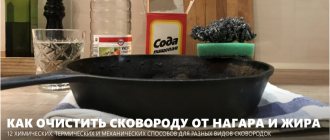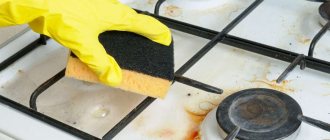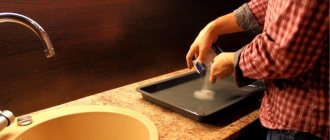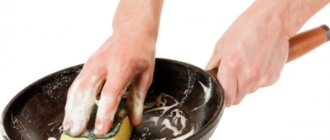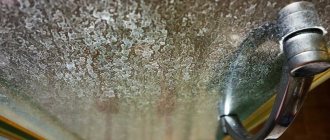The gas stove is rightfully considered one of the most quickly dirty and problematic kitchen surfaces. In addition to the handles and oven, caring for a gas stove is also complicated by the presence of a grate and burners, from which it is most difficult to remove clogged dirt such as grease, soot, and burnt sugar.
The question of choosing between folk remedies and household chemicals is individual for each housewife. Everything is decided by convenience and accessibility. Read more about ways to clean gas stoves in our material.
Folk remedies for fat and soot
Baking soda
The substance is diluted to a paste-like consistency, which requires ½ cup of soda and 3-5 tablespoons of water. The mixture is applied with the soft side of a sponge or a rag. It is better not to use soda ash, as it contains alkali, which can cause scratches.
Soap solution
Most often, 72% laundry soap is used. The third part of the bar is grated on a regular coarse grater and mixed with 5–7 liters of hot water. A substitute for laundry soap, but less effective, can be dishwashing detergent or washing powder.
Vinegar
Mixes with water in a 1:1 ratio. There are two options for use: spraying from a spray bottle or wetting a sponge in the prepared solution.
Ammonia
Similarly with vinegar, dilute with water 1:1. It is also recommended to use ammonia after the first treatment with soap or soda solution to remove old stains.
There are a number of substances and products whose properties also allow them to be used to remove dirt from gas stoves. Among them are ammonia, dry mustard, river sand, and lemon juice.
You need to be very careful when using abrasives and metal brushes, which can cause small scratches and cause faster contamination in the future. A hard sponge, for example, can be replaced with an old toothbrush.
Step-by-step cleaning instructions
To clean a gas stove at home, you must perform the following steps:
- The first thing to do is to ensure the safety of the process. After all, when cleaning, you may accidentally touch the stove handle and turn on the gas. Therefore, completely turn off the gas supply and disconnect the gas stove from the power supply (if there is an electric ignition function). This precaution will ensure maximum safety during cleaning.
- Now you should prepare a solution of laundry soap. To do this, grate about a quarter of the piece and dissolve it in 6 liters of hot water. You can clean the grate with this mixture. Simply remove it and immerse it in a large container of solution so that it completely covers the part.
- Then you should remove the stainless steel burners, which, along with the grate, have persistent dirt of a similar composition and place them in the same basin with a soap solution.
- Now you need to remove small dirt, crumbs and food debris from the surface of the stove. This can be done with a regular hard sponge. An important condition is that you should not wet the stove with water, otherwise the entire cleaning process will become much more complicated.
- To clean the handles and oven, you will need to consider many more complex aspects that are worth considering separately. These are the most labor-intensive and difficult stages; any housewife with experience will confirm this. But the preparatory stage has come to an end. All that remains is to remove the handles.
How to clean the handles of a gas stove
There are different options for cleaning removable and non-removable handles. For removable ones the process is simpler. They are soaked in vinegar or soap solution for 1–2 hours.
Difficult to remove stains are removed using a sponge soaked in ammonia diluted with water. A more radical option is to immerse the handles in a solution with ammonia, placing it on the switched-on burner for 7-10 minutes. After the liquid has cooled, rinse the handles with running water.
For non-removable ones, you will need ammonia or vinegar solution sprayed onto the surface of the handles. After 5–10 minutes, wipe the surfaces with a clean, dry cloth. To clean the grooves and crevices on the handles, you can use a toothbrush, cotton swabs and toothpicks.
Cleaning the oven
To clean the oven from old grease stains, you can use special products. But after using them, an unpleasant odor remains, and there is a risk of chemicals getting into the food. Therefore, it is better to clean the oven with folk remedies.
Soda is suitable for these purposes. Vinegar copes well with the problem of soot. Some housewives use salt to clean the oven at home. The components contained in the substance soften the fat and make it porous, so after heating the sodium chloride, stains are easily removed from the cooking surface.
How to clean gas stove grates
First you need to remove large dirt (food debris, greasy deposits, carbon deposits). Most of the dirt accumulates in the corners and places where the grate touches the stove. The easiest way to remove them is with a scraper (plastic and wooden) or a metal brush. But such methods are only relevant for cast iron and steel gratings and are not suitable for enameled ones.
Treatment with soda solution
The entire surface of the grate is treated with a sponge, after which it is left for several hours. Next, grease and dirt are removed with a rag or sponge. If there are uncleaned areas, go over the cast iron or steel grate with a stiff sponge or wire brush.
with ammonia and the entire grate is treated. To achieve the desired effect and eliminate unpleasant odors, it is better to put the grill in a plastic bag and leave it in it for 2–3 hours. Later, it is washed with dishwashing detergent and grease and carbon deposits are removed with a sponge.
When using a soap solution, you will need a container of a size and shape suitable for the grill (basin, bucket, sink). The grate will have to soak for several hours, after which it will be washed and cleaned. This method is great for enameled and steel gratings.
A dishwasher for removing dirt is only suitable for enamel racks. As for cast iron, a long stay of the material in water is fraught with the appearance of rust.
The product for car engines will remove grease and carbon deposits, but you will have to tinker a lot with washing off the remaining chemicals from the surface of the grille.
Ammonia, in turn, is a fairly effective means of getting rid of traces of fat. To do this, pour a glass of the substance onto a baking sheet and place it in an oven preheated to 100 degrees for about half an hour or a little longer. The cooled baking sheet is cleaned with a sponge, detergent and water.
Various types of surfaces
When choosing preparations and methods for washing gas stoves, be sure to take into account the materials from which the working panel is made. The most common types:
- metal coated with enamel;
- stainless steel;
- glass ceramics.
The table highlights problems that commonly arise in the kitchen and the most suitable cleaning products.
| Surface material | Types of pollution | Facilities | Notes |
| Glass ceramics | Stains, whitish, pearlescent or bluish spots | Professional household chemicals for glass-ceramic hobs. Soda slurry, table vinegar, soap solutions | The use of preparations with abrasives and alkalis is excluded |
| Stainless steel | Scale, carbon deposits, rust, traces of chlorine compounds, grease | Soap solution, soda slurry. Table vinegar, activated carbon. For fresh dirt (drops of grease, stains), dishwashing gels are suitable. It is advisable to periodically resort to the help of professional pastes and creams for stainless steel. | Do not use compounds with chlorine, alkalis, or use abrasives. It is recommended to polish after cleaning |
| Enameled | Soot, traces of rust, soot | Soda, vinegar, activated carbon. Household chemicals | Metallic sponges, hard sponges, and brushes are excluded. Do not use abrasives |
How to clean gas stove burners
The lids removed from the burners are soaked in a soapy solution, possibly together with the grate. The burners themselves should be removed and wiped with a damp cloth or sponge. You should make it a habit to check the burners every time you clean your stove.
It is important to ensure that the flow of gas is not obstructed by dirty deposits. If present, the holes and recesses should be cleaned. To do this, you can use wire, an unbent paper clip, or even a needle.
Cleaning the grate and burners
Steel, stainless steel or cast iron grates and burners are the most durable and chemical-resistant parts, so there are many options for effectively cleaning the grate of a gas stove at home.
- The easiest and most effective way to clean them is to put them in the dishwasher. To do this, pour more dishwashing liquid into the machine. After completing the procedure, simply dry the stainless steel grates.
- If you do not have a dishwasher, then you should leave the grate and stainless steel burners soaked in soapy water for at least twelve hours. After this, the dirt will be very easy to wash off, and this part of the gas stove will again shine with pristine cleanliness.
- If the stains are very persistent, then after pre-soaking you should use regular sand or baking soda. Then you need to rinse the part under running water and dry it.
In order to prevent the adhesion of new contaminants, there is a very simple and effective way. The next time you clean, you won’t need to wash for hours; just rinse the grate and stainless steel burners with warm water, and the dirt and grease residue will come off instantly. So, apply the following mixture to the dry surface of the grate and stainless steel or steel burner, free of carbon deposits:
- Soda Ash;
- Washing powder;
- Transparent office glue.
The ratio of the component parts should correspond to the proportion 6:1:2. This will need to be repeated regularly, at least once every three months.
Cleaning the glass ceramic hob
Soap solution and special products (creams, pastes, sprays) are best suited for cleaning glass-ceramic stoves. In addition to the fact that they do a good job of cleaning, they create a kind of film and add shine. Apply the solution and remove dirt with a soft sponge or glass scraper, which should be positioned at an acute angle to the surface.
Soda should not be used, as it has abrasive properties, causing the surface to become covered with small scratches. This cleaning method can be left as a last resort if it is not possible to use other means. It is important not to let the baking soda dry, otherwise the coating will be damaged.
To make it easier to remove stains from the surface of the stove olive oil should be poured onto the area requiring cleaning and left for 20 minutes.
The vinegar solution also does a good job of removing dirt, but also disinfects the surface.
ammonia-based window cleaner Next, it is wiped with a microfiber cloth.
Features of cleaning different surfaces
The body material of modern gas stoves is enameled metal or stainless steel . The advantage of an enameled surface is durability. It is resistant to corrosion provided that there are no scratches or chips on it. The disadvantage is the sensitivity of the enamel to prolonged exposure to chemical cleaning agents.
They corrode the coating, the slab takes on an unpresentable appearance, and fat sticks to the damaged surface even more.
Stainless steel is a more practical material. Its advantages are ease of maintenance and wear resistance. Stainless steel does not chip, it looks expensive and elegant. The disadvantage of stainless steel surfaces is the need for daily maintenance. Even small stains and water drips give it an untidy appearance.
Question to the expert
Can any means be used to remove contaminants?
Both types of surfaces do not tolerate cleaning with harsh abrasives and metal brushes.
Top 5 cleaning chemicals for grease and carbon deposits
Synergetic belongs to the middle price category, equipped with a dispenser for ease of use and economical consumption.
Sanita is a quick-acting alkali-based product, suitable for all surfaces, without a pungent odor, and perfectly removes dirt and greasy deposits.
“Oven Cleaner”, Amway is an effective product with a thick consistency, has a pungent odor, lasts a long time, and belongs to the high price segment.
Bagi, Shumanit is a liquid or powder product for various types of surfaces, easy to use, effective, affordable, and has a pungent odor.
Cif is a universal product for many surfaces, better suited for fresh dirt and removing old grease, has a pleasant smell, and has a quick cleaning effect.
All household chemicals are available in several forms: liquid, gel, spray or powder. Liquid cleaners, as a rule, are used more economically because they are diluted in small quantities in water.
With the help of a spray, fat is removed more easily from hard-to-reach places. Gels are available with or without abrasive to protect surfaces from scratches. Powders are intended for hard surfaces that can withstand abrasive substances.
Effective means
@obzorus.com
The modern household chemicals market offers a wide variety of detergents that are designed to care for the stove. Their main advantage is their high efficiency in removing contaminants of any degree, while such products contain harmful components that can have a negative effect on the skin and the body as a whole.
Important! When using household chemicals, it is recommended to use gloves and not inhale harmful fumes; this approach will protect yourself.
An alternative option is folk remedies that cope well with pollution and do not harm health. Practice shows that housewives more often prefer to use folk remedies, while in professional kitchens detergents from the category of household chemicals predominate.
How to clean the oven
Soda
A soda solution is applied to all internal surfaces, except heating elements. If in certain areas the mixture darkens and turns brown (from soot and grease), you need to treat them more carefully.
In this state, open the oven slightly and leave for 12 hours or overnight. After time, use a damp cloth to remove as much dirt as possible. If necessary, use a plastic scraper.
For areas with difficult-to-remove dirt, spray a vinegar solution , which reacts with baking soda to form a soft foam. Next, everything is wiped off from plaque and foam.
Lemon acid
If time is short, there is a faster way to clean your oven. It is turned on and heated to a maximum of 200 degrees. Pour water with citric acid dissolved in it (10-20 g) into a container suitable for high temperatures or onto a baking sheet.
Place the baking sheet or container in a preheated oven on the lower level and leave until the liquid boils. Next, turn off the oven and leave for 30 minutes, then wipe thoroughly.
Salt
The baking tray, where the salt is evenly scattered, is placed in an oven preheated to 100 degrees for half an hour. After cooling, the salt is scraped off with a plastic or silicone scraper, and the baking sheet is wiped with a damp cloth or sponge.
Removing grease stains from the surface
The first assistant in the fight against greasy stains is hot water. Of course, it will not completely break down fat, especially old and dried-on fat, but it will be able to soften it. After this, soda comes into play. Distribute it evenly over the surface of the stove, generously moistened with hot water, and leave for half an hour. The effect will be enhanced if you use a soap solution.
After the slab has soaked, thoroughly wipe off the applied mixture with a soft sponge. Now wipe the surface with a 1:1 solution of water and ammonia.
Attention! Do not use metal brushes or sponges. You will scratch the surface with them, and subsequent contaminants will settle much more firmly on the damaged areas. If a regular sponge doesn't do the job, use a toothbrush. A cotton swab will help clean hard-to-reach places.
Use laundry soap for cleaning. Rub part of the bar and add some hot water. Mix to a paste and apply evenly to the surface. Leave for 15 minutes, and when the fat has subsided, rinse with warm water. Wipe off any remaining product with a clean cloth.
A toothbrush will help clean hard-to-reach places
Lemon juice, vinegar and citric acid will also be effective helpers against fat. Apply any of these products to the entire surface of the stain and wipe off after 15-30 minutes. Also, burnt areas or dried grease stains will be destroyed by a solution of vinegar and ammonia.
It is much easier to deal with if there are stains on your stove from syrup, coffee or cocoa containing sugar. In this case, regular hot water will help you. At high temperatures, sugar turns into caramel, which is difficult to clean, but easily dissolves in water in just 15-20 minutes.
How to care for the hob
The hob itself and the lid of the gas stove need regular wiping with a damp sponge. If dirt cannot be removed, use a special detergent. For dried stains, not soft sponges, but mesh sponges are suitable.
You can use a saline solution (2 tbsp per 0.5 l of water). The liquid is applied to the stove, left for 10-12 hours and then wiped with a cloth and water.
How to avoid contamination:
- When cooking, monitor the flame so that it does not go beyond the bottom of the container.
- When boiling liquid should not fall on the gas stove burners.
- Wipe the hob with a sponge and water after each meal preparation.
- When baking in the oven, containers must be covered with special paper or foil.
Practical advice
In order not to bring the condition of the gas stove to a critical state and not waste time on major cleaning, it is important to follow preventive measures. They will help you avoid stubborn stains and protect the surface from burnt stains and grease:
- When preparing dishes that are prone to splattering of fat, use special foil covers. They already have slots for the burners and fit perfectly on the hob. At the end of cooking, the pad can be thrown away or used again.
- Try to always keep the stove in order. Fresh stains are much easier to clean than old ones. Even the next day it is already more difficult to deal with the pollution.
- Cover pots and pans with lids that stop splashes and prevent them from reaching the surface of the gas stove.
- Do not leave spilled liquid on the stove and hope it will evaporate on its own. As a rule, even clean water will leave behind streaks and yellow spots.
As you can see, cleaning a gas stove is not a difficult task, but it is painstaking. By following these simple tips, you will maintain the attractiveness of its appearance, and it will serve you for many more years.



